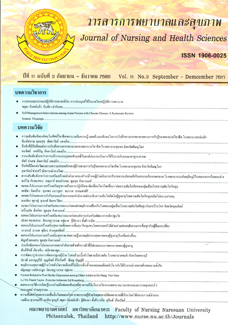Effects of Self-Regulation Program with Exercise on Blood Pressure in Elderly with Essential Hypertension
Main Article Content
Abstract
The purpose of this quasi-experimental research with two group design was to examine effects of self-regulation program with exercise on blood pressure in elderly with essential hypertension. The sample was 60, divided into the experimental and control group, 30 subjects in each group. The control group received routine nursing care while the experimental group received self-regulation program with exercise, based on the concept of Kanfer and Gaelick-Buys (1991). The program consisted of 1) Self – monitoring 2) Self - evaluation 3) self – reinforcement the program for 12 weeks. The instruments for data collection included: demographic data questionnaire, Sphygmanometer ,Stethoscope and self-regulation program with exercise on blood pressure in elderly with essential hypertension. Data collection was done in 4 weeks, 8 weeks and 12 weeks after intervention. The data were analyzed by using frequency, percentage, mean, and standard deviation. The hypotheses were tested by using repeated measure design ANOVA and Independent t-test. The results of the study revealed that: 1. The average mean score of self-regulation with exercise behaviors of the experimental group after implementation the program 4 weeks, 8 weeks and 12 weeks were the significant difference at 0.001 level. 2. The average mean score of systolic blood pressure of the experimental group after implementation the program 4 weeks, 8 weeks and 12 weeks were the significant difference at 0.05 level. The average mean score of diastolic blood pressure of the experimental group after implementation the program 4 weeks, 8 weeks and 12 weeks were no statistical significance. 3. The average mean score of blood pressure of the experimental group was significantly lower than the control group at 0.05 level.
Article Details
References
แกว่งแขนและการเดินที่มีผลต่อสุขสมรรถนะ
ของผู้สูงอายุ. วารสารวิทยาศาสตร์การกีฬาและ
สุขภาพ. 13(1), 92-103.
คลินิกโรคไม่ติดต่อเรื้อรังโรงพยาบาลศรีนคร. (2557).
ตัวชี้วัดงานคลินิกโรคไม่ติดต่อเรื้อรัง. สุโขทัย:
คลินิกโรคความดันโลหิตสูง.
ปิยนุช คนฉลาด. (2542). กายบริหารแกว่งแขน บำบัดโรค.
วารสารศึกษาศาสตร์ มหาวิทยาลัยบูรพา. 12(1),
131-138.
ปุณยวีร์ ประเสริฐไทย. (2553). ผลของการออกกำลังกาย
ขนาดความหนักปานกลางที่บ้านในการลด
ความดันโลหิตของผู้ที่มีภาวะความดันโลหิต
เกือบสูง. วารสารสภาการพยาบาล, 25(4), 80-95.
เพ็ญศรี เมืองรี. (2557). ผลของโปรแกรมการจัดการตนเอง
ต่อพฤติกรรมสุขภาพและระดับแอลดีแอล
โคเลสเตอรอลของผู้สูงอายุกลุ่มเสี่ยงไขมัน
ในเลือดผิดปกติ. วารสารการพยาบาลและสุขภาพ.
8(1) , 72-81.
ศุภวรรณ มโนสุนทร ,นพวรรณ อัศวรัตน์ และสุภาพร
พรมจีน. (2558). คูมื่อประเมินการดำเนินงานคลินิก
NCD คุณภาพ ปีงบประมาณ 2558. นนทบุรี:
สำนักงานโรคไม่ติดต่อ กรมควบคุมโรค.
ศูนย์ข้อมูล สาธารณสุขจังหวัดสุโขทัย. (2558). จำนวน
ผู้ป่วยโรคเบาหวานและความดัน. สืบค้น
เมื่อวันที่ 14 มิถุนายน 2558, จาก http://info.skto.
moph.go.th/personchronic.
สถาบันวิจัยและประเมินเทคโนโลยีทางการแพทย์
กรมการแพทย์. (2555ก). คู่มือการให้ความรู้ เพื่อ
จัดการภาวะความดันโลหิตสูงด้วยตนเอง.
นนทบุรี: องค์การสงเคราะห์ทหารผ่านศึก.
สถาบันวิจัยและประเมินเทคโนโลยีทางการแพทย์
กรมการแพทย์. (2555ข). แนวทางเวชปฏิบัติการ
ออกกำลังกายในผู้ป่วยเบาหวานและความดัน
โลหิตสูง. นนทบุรี: สำนักงานกิจการโรงพิมพ์
องค์การสงเคราะห์ทหารผ่านศึกในพระบรม
ราชูปถัมภ์.
สมศักดิ์ ผดุงจิตร์. (2544). ผลของการออกกำลังกาย
แบบแกว่งแขนที่มีต่ออัตราการเต้นของหัวใจ
ความดันโลหิตและน้ำหนักร่างกายของหญิง
สูงอายุ. วิทยานิพนธ์ วท.ม., มหาวิทยาลัย
เกษตรศาสตร์, กรุงเทพฯ.
สำนักงานนโยบายและยุทธศาสตร์ กระทรวงสาธารณ
สุข. (2557). จำนวนและอัตรา ผู้ป่วย โรคความ
ดันโลหิตสูงต่อประชากรแสนคน ปี พ.ศ.
2550-2556. สืบค้นเมื่อ วันที่9 มกราคม 2558,
จาก http://thaincd.com/information-statistic/noncommunicable-
disease-data.php.
สุกัญญา สุขวิญญา. (2551). ผลของโปรแกรมส่งเสริม
การจัดการตนเองต่อพฤติกรรมการควบคุม
โรคและระดับความดันโลหิตของผู้ป่วยความ
ดันโลหิตสูง. วิทยานิพนธ์ พย.ม., มหาวิทยาลัย
นเรศวร,พิษณุโลก.
สุพิณญา คงเจริญ. (2556). ผลของโปรแกรมการกำกับ
ตนเองเพื่อควบคุมความดันโลหิตต่อพฤติกรรม
การกำกับตนเอง ระดับ ความดันโลหิตและ
ภาวะเสี่ยงต่อการเกิดโรคหลอดเลือดสมองใน
ชาวไทยมุสลิมที่เป็นโรคความดันโลหิตสูง.
พยาบาลสาร. 40(1), 23-33.
อภิชญา เสียงลือชา, ภัทราวุธ อินทรกำแพง และ
ถนอมศักดิ์ เสนาคำ. (2551). การศึกษาระดับ
ความหนักเบาของการออกกำลังกายแกว่งแขน
ขณะนั่งและยืนในคนปกติ. เวชศาสตร์ฟื้นฟูสาร.
18(3), 90-97.
Annual Epidemiological Surveillance-Report 2012.
(2012). โรคความดันโลหิตสูง(Hypertension).
Retrieved October 10, 2014,from http://www.
boe. moph.go.th/.
Chobanian, A.V., Bakris, G. L., Black, H. R., et al.
(2003). The Seventh Report of the Joint
National Committee on Prevention Detection,
Evaluation, and Treatment of High Blood
Pressure. The JNC 7 Report. JAMA. 289(19),
2560-2571.
Kanfer, F. H., & Gaelick -Buys, L. (1991). Selfmanagement
methods. In F. H. Kanfer, and A.
Goldstein (Eds.), Helping people change : A
textbook of methods, (4thed., p.305-360).
New York: Pergamon Press.
Whelton, S.P. Chin,A. Xin, X. & He,J. (2002). Effect of
aerobic exercise on blood pressure: A Meta-
Analysis of randomized, controlled trails.
Annals of Internal Medicine. 136(7), 493-503.
World Health Organization Regional Office for South-
East Asia. (September 2011). Hypertension fact
sheet Department of Sustainable Development
and HealthyEnvironments. Retrieved October
10, 2014, from http://www.searo.who.int/
entity/noncommunicablediseases/media/
noncommunicabledisease hypertension fs.pdf.


